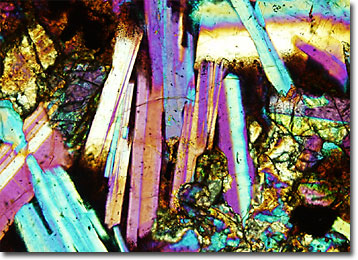Polarized Light Microscopy Digital Image Gallery
Tholeiitic Basalt
Basalts are a group of fine-grained extrusive igneous rocks that have a relatively low silica content, but otherwise vary significantly in composition and appearance. They may, for instance, be compact, smooth, and glassy or porphyritic and can exhibit a wide range of colors, such as dark green, reddish brown, gray, or black.

Two major groups of basalts are generally scientifically recognized: tholeiitic basalts and alkali olivine basalts. Tholeiitic basalts are formed from magmas of the same name, which produced the mid-ocean ridge basalt and built the Hawaiian Islands, Iceland, and other mid-oceanic landmasses. This type of basalt is present on Earth in much greater amounts than alkali olivine basalt, which occurs along continental rifts and on oceanic islands. The dominant materials that comprise tholeiitic basalt are plagioclase feldspar, clinopyroxene, and iron ore. Unlike alkali olivine basalts, the fine-grained tholeiites contain little or no olivine.
Basalts are not only found on Earth, but on the moon and other planets as well. In fact, many of the moon rocks obtained during the Apollo space missions are basalts, though they are slightly different than terrestrial forms of the rock. More specifically, the lunar basalts lack organic compounds and water and contain greater amounts of iron, magnesium, and various other elements. Basalt samples have also been obtained from Venus by the Venera series of satellites developed by the former USSR. Some of these basalts were tholeiitic and quite similar to those found on the Earth’s mid-ocean ridges. The occurrence of basalts in these other locales presents important information about their history, providing evidence that the moon and Venus experienced geologic events that included massive amounts of heating and melting.
